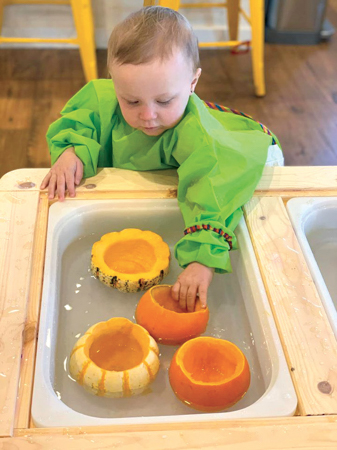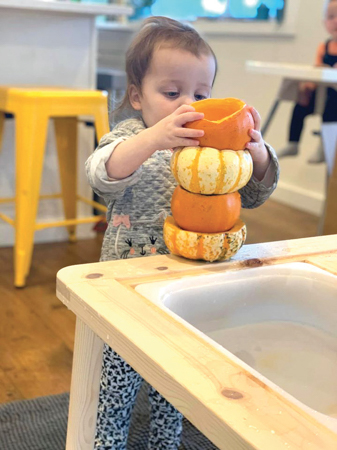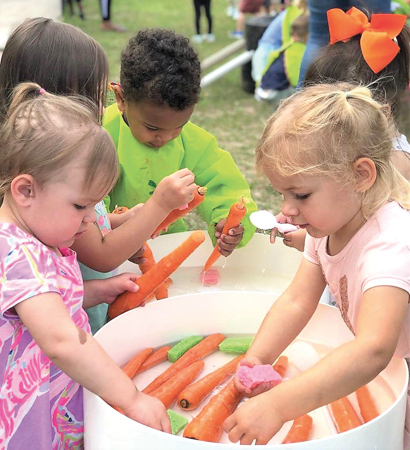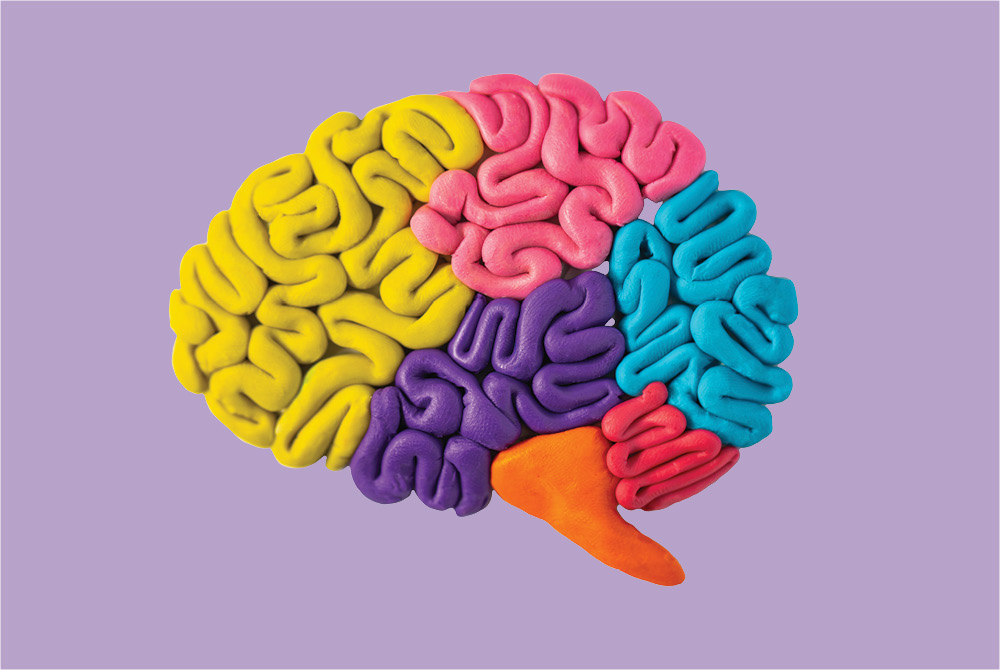Have you ever observed honey bees when they are flitting around and nosing up to brightly colored and sweet-smelling flowers? Pause to observe, and you may notice how these busy bees repeatedly nuzzle and flit as they quickly buzz around the flowers. These repeated actions of flitting, gathering, collecting, and taking their found treasure back to the honeycomb are innate and instinctive behaviors. The same is true for very young children. They move about their environments, collect bits and pieces of information about their world, and store this data in their honeycomb brains.
The Honeycomb Hypothesis uses the analogy of a honey bee to help explore how infants, toddlers, and twos learn. Figure 1 shows a brief glimpse of some similarities between honeybees and children’s instinctive behaviors.
Children create understandings of the world through their own actions and interactions with the environment. They must have a multitude of opportunities and experiences with (1) collecting many bits and pieces of data through patterns of play movements throughout their environments; (2) storing the information in their brains; and, (3) making connections between the bits and pieces they have collected, in order for them to construct meaningful and unique understandings, which are called mental models or schemas (Figure 2).
Figure 1: The Honeycomb Hypothesis
Figure 2

Honeycomb Hypothesis In Real Life
So, how does all this happen in real life? In your mind’s eye, imagine the honeycomb as a child’s brain. Each cell of the honeycomb brain contains bits and pieces of information or specific data (schemas/mental models), which the child has learned through freedom of movement and child-led play. For example, in a 2-year-old classroom, a teacher has created a special place for playing with clay. It includes a significant amount of authentic clay (not playdough), a rimmed table so that clay is less likely to fall on the floor, some authentic wooden kitchen utensils, and a bucket of sudsy water for initial clean-up. A picnic rug has been placed under the table to catch excess clay and potentially reduce the mess. There are several small balls of clay that have been placed in a covered plastic container, so that children can help themselves just as they might when taking cookies from a cookie jar. Nearby is a low shelf where children can display their clay pieces.

As children experience clay through patterns of play, they collect data about it’s elements, such as color, gooeyness, squishiness, and stickiness. [©Michelle Pratt]
- The child might accommodate the notion of the brown clay by altering her pre-existing concept of butterscotch pudding and put the clay into that schema. OR …
- The child may decide the clay does not fit at all into the butterscotch pudding schema and decide to build a new cell in the honeycomb to store clay data. AND …
- The child may link together existing schemas with new schemas to form other understandings.
ADVERTISEMENT
Problematic Pedagogy: The Color Orange

True learning happens when children are given the luxury of creating their own meaning. [©Little FLowers Full Day Preschool, LLC]

[©Little FLowers Full Day Preschool, LLC]
- First, she brings an orange ball into the classroom and rolls it back and forth to the toddler saying orange ball. The toddler happily rolls (or kicks) it around the room.
- The next day, the teacher places several different-sized pumpkins on the floor in the middle of the room. The same toddler picks up one of the smaller pumpkins, tries to put it in his mouth, roams about the classroom, and eventually carries it the other side of the room and hides it behind the light table.
- Then, the California-based teacher takes the children on a short walk to a friend’s home where they pick ripe and delicious fruit from the orange tree in the backyard.
- Back on the center’s play yard, children participate in a game of putting the oranges into a large metal bowl, dumping them out, and watching them roll down a small hill where children stop the oranges from rolling with their hands and feet. They play this game over and over again.
- The teacher peels and breaks the oranges into segments and gives children orange pieces to taste.
- Finally, the teacher has purchased a handful of orange kumquats at the local specialty grocery store. After placing them in a small wicker container, she put the basket in the middle of the home living table where the children enjoyed cooking and stirring the kumquats in a pot on the stove.
With all of these orange experiences, the toddler teacher was able to observe many repetitive behaviors or patterns of play, such as Turning & Stopping, Making & Unmaking, and Carrying & Placing. Although these patterns of play were visible, the schemas (or mental models) that children are creating in their brains as a result of these behaviors are invisible.
Schemas Are Invisible
A great amount of intentional planning was done by the toddler teacher in an effort to teach children about the specific color of orange. But, is that what is really happening? Are children really learning the color concept of orange … or not?
Unless we are brain scientists or have access to magnetic resonance imaging brain scanning, it is impossible to see children’s learning processes and, therefore, educators cannot begin to assume they know what is happening in children’s brains. So, while we presume children are learning the color orange because we give them multiple types of experiences with this color, the fact of the matter is that children might be filling up their honeycomb cells with something quite different than the concept of the color orange.

[©Kinderoo Children’s Academy/Martha Anzola]
More importantly, is it really that necessary for toddlers to know the difference between the color orange and the color red? What is the reasoning for this insistence? Just because toddlers have memorized which color is orange or can sing the alphabet song without missing a beat does not mean they have meaningful understandings of these concepts—it just means they have good memories. The Honeycomb Hypothesis asserts it is important for children to create their own learning and go beyond rote memory. True learning happens when children are given the luxury of creating their own meaning. As Piaget suggested, educators must get out of children’s way. This can only happen when teachers provide opportunities for promoting understandings, rather than merely teaching concepts.
Educators must let children fill up their own honeycombs in whatever way they wish. If children want to put the pumpkin in the “orange” cell, that is okay. If they want to, however, put the pumpkin in the “round” cell, that is also okay. Or, if young learners decide to put the pumpkin in the “rolling” cell because they were able to roll it down a ramp, that is perfectly fine. In short, educators should not be telling children where to put their bits and pieces of collected data, because if we do, there is little meaning or understanding.
Embracing a Pedagogical Shift
If we can agree that the development of children’s schemas is something that cannot be seen, then it becomes easy to understand what we must do. The answer is so simple: change pedagogical practices to promote children’s understandings, rather than rote knowledge. There needs to be a shift in pedagogical paradigms from focusing on the acquisition of knowledge of basic facts such as shapes, colors, and alphabet, to a pedagogical emphasis on offering children opportunities for developing meaningful understandings.
The goal of pedagogy is not to gain knowledge, but to promote children’s understandings.
The goal of pedagogy should be to provide intentional learning experiences for children to practice different patterns of play, in order for them to develop schemas, fill up their honeycombs, and create connections between combs just as the toddler teacher did. In other words, do exactly what the toddler teacher did but with one exception: change the learning expectation. Rather than focusing on specific knowledge, isolated concepts, or the color orange, the goal of the toddler teacher’s pedagogy could be for children to create understandings and make connections with the data, information, and experiences offered about orange.
The color orange is the sideshow, not the main attraction.
When the teacher focuses on promoting patterns of play, children will naturally or organically learn not only the color orange, but so much more. Here are a few ideas for promoting children’s understandings.
- Provide a variety of loose parts, so children can explore and experience the different properties of the objects such as shape, size, hardness, softness, and transparency. Through these multiple experiences, children will gain understandings of their characteristics—including the color orange!
- Offer three-dimensional and multi-sensorial activities that allow children to engage their senses of touch, taste, smell, hearing, and sight, as well as whole body movements, so children will gain sensory insights and make connections between these insights with the world around them.
- Steer away from rote learning and memorization including one-answer, single-use materials (i.e., flashcards, posters, worksheets,) because these materials do not allow children to actively engage in patterns of play.
The Honeycomb Hypothesis invites you to move away from problematic pedagogy by abandoning the notion of teaching for children’s knowledge (i.e., basic shapes, colors, numbers, letters). Rather, the Honeycomb Hypothesis is asking for a shift in your mindset. This paradigm shift requires us to embrace the idea of encouraging children to discover their own personal and unique understandings. With this fresh pedagogical perspective, children’s learning will evolve organically and they will become critical thinkers, creators, and innovators ready to be productive citizens who will contribute to tomorrow’s society. Never fear—they will learn the color orange but, in the process, will learn and become much, much more.
Inspirations and Resources
Atherton, F. & Nutbrown, C. (2016). “Schematic Pedagogy: Supporting One Child’s Learning at Home and in a Group.” International Journal of Early Years Education. 24(1), 63-79.
Beloglovsky, M. & Daly, L. (2015). Early Learning Theories Made Visible. Redleaf Press.
Curtis, D. & Jaboneta, N. (2019). Children’s Lively Minds. Schema Theory Made Visible. Redleaf Press.
Duncan, S., Penix, S., & Haughey, S. (Forthcoming 2022). The Honeycomb Hypothesis: How Infants, Toddlers and Twos Learn Through Nature Play. Exchange Press.
Halford, G. (1993). Children’s Understanding: The Development of Mental Models. Psychology Press.
Jana, L. (2017). The Toddler Brain. Da Capo Press.
McLeod, S. (2018, June 06). Jean Piaget’s Theory of Cognitive Development. Simply Psychology. simplypsychology.org
Nutbrown, C. (2006). Threads of Thinking, Young Children Learning and the Role of Early Education. Sage Publications.
Piaget, J. (1952). The Origins of Intelligence in Children. Translated by Margaret Cook. International Universities Press.
Piaget, J. & Inhelder, B. (1969, 2008). The Psychology of the Child. Basic Books.
Piaget, J. (1973). The Child and Reality. Viking Press.
Slater, A. (2004). Novelty, familiarity, and infant reasoning. Infant and Child Development, 13(4), 353-355.
Wadsworth, B. (2004). Piaget’s Theory of Cognitive and Affective Development: Foundations of Constructivism. Longman.
Sandra Duncan works to assure the miracle and magic of childhood through indoor and outdoor play space environments that are intentionally designed to connect young children to their early learning environments, communities, and neighborhoods. Duncan is an international consultant, author of six books focused on the environmental design of early childhood places, designer of two furniture collections called Sense of Place and Sense of Place for Wee Ones, and adjunct faculty at Nova Southeastern University. She has designed university courses on indoor and outdoor learning environments, collaborating with architects, interior designers and educators to create extraordinary places and possibilities for children and students of all ages.
Related
ADVERTISEMENT













